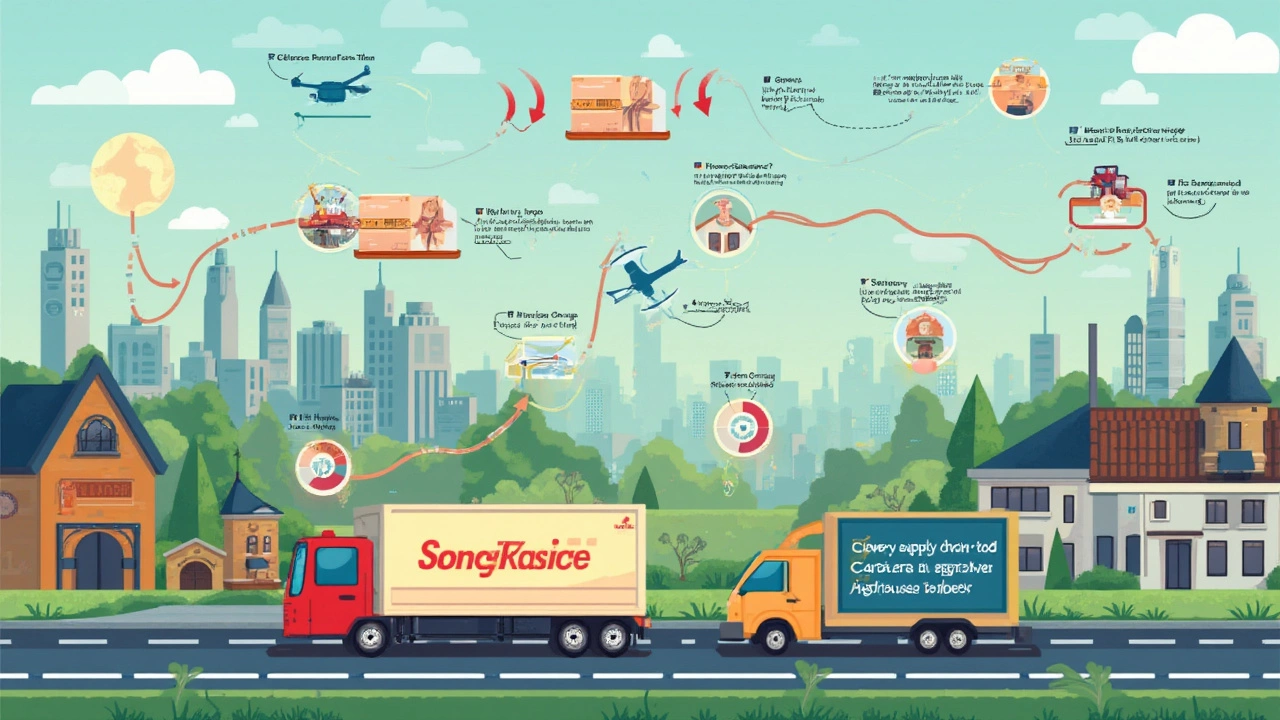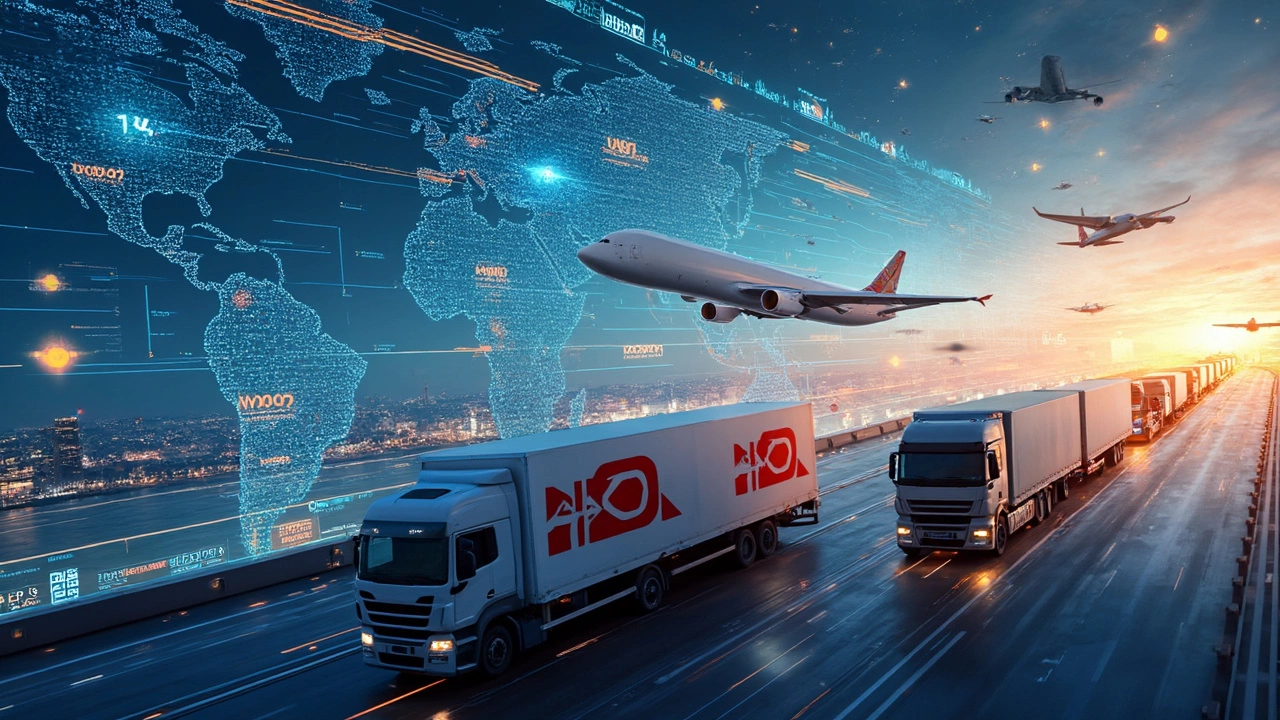Think about this: every time you order something online or see fresh fruit from another country at the store, a huge, powerful logistics company helped make that happen. These companies aren’t just moving boxes—they’re pulling off giant puzzles that touch every part of your daily life.
But who’s the absolute heavyweight champion when it comes to money and global reach? Most folks guess FedEx or UPS, but there’s actually a different name at the top—one you might not even think of first. If you’re running an online store, own a small business, or just want to get stuff from point A to point B faster, knowing who’s ruling the logistics game can give you fresh ideas for your own shipping and supply chain plans.
The richest logistics company dominates not just because of flashy ads or a big brand, but because they handle a ridiculous number of shipments, cover crazy distances, and know how to save costs everywhere. They use technology in ways you probably never imagined—think drones, AI, and fleets of planes and ships. Stick around, and you’ll see just how these big players turn moving stuff into mountains of cash, plus a few tricks you can steal for yourself.
- What Is a Logistics Company?
- Meet the Richest Logistics Player
- Why Are They So Profitable?
- Cool Facts About Global Logistics
- What You Can Learn From the Top Dogs
What Is a Logistics Company?
Logistics companies make sure products get from the point where they’re made to where they need to be—without headaches, lost boxes, or chargeback drama. At the core, they’re all about moving stuff the fastest, safest, and cheapest way possible. That means handling storage (warehousing), getting things sorted out, and shipping them across the region, the country, or the globe.
These companies don’t just deal with big trucks or warehouses. They’re also behind the scenes with customs paperwork, inventory planning, technology that tracks your package by the second, and problem-solving when weather or world events throw a wrench into the works. Some juggernauts even manage fleets of airplanes, container ships, and thousands of delivery vans, making sure nothing gets stuck along the way.
Check out what a modern logistics company usually deals with:
- Transportation: Trucks, ships, planes, and sometimes even drones.
- Warehousing: Storing and organizing all those products before they move out.
- Distribution: Getting orders to the right place on time (and in one piece).
- Inventory Management: Making sure there’s never too much or too little of anything.
- Customs and Regulations: Handling paperwork so goods can cross borders without delays.
It’s a huge business. Looking at recent numbers, global logistics was valued at over $9 trillion in 2024. That’s about the economic size of Germany and India combined!
| Year | Global Logistics Market Value (USD) |
|---|---|
| 2020 | $7.6 trillion |
| 2022 | $8.1 trillion |
| 2024 | $9+ trillion |
Fun fact—some companies can deliver over 20 million packages a day. Efficiency, technology, and scale are the real magic here. The biggest names in logistics have systems running 24/7 to keep shipments flowing, no matter what’s happening in the world.
Meet the Richest Logistics Player
When it comes to money and muscle in the logistics world, richest logistics company is a title you can only hand to DHL Group (formerly Deutsche Post DHL Group). If you check their numbers, DHL pulls in way more revenue than giants like FedEx or UPS. In 2024, DHL Group’s global revenue shot past $94 billion, putting them squarely at the top of the pile.
DHL is everywhere. They deliver packages and freight in more than 220 countries. That’s more than almost any global network out there. While most folks think of DHL for Express parcel services, they’re huge in supply chain management, freight by air and sea, and contract logistics for big brands like Adidas and Volkswagen.
Here’s a quick peek at some recent stats so you can see just how big they are:
| DHL Group (2024) | FedEx (2024) | UPS (2024) |
|---|---|---|
| $94.6B revenue | $87.9B revenue | $91.0B revenue |
| 600,000+ employees | 500,000+ employees | 500,000+ employees |
| 220+ countries served | 220+ countries served | 220+ countries served |
What’s nuts is how they keep growing. DHL isn’t just coasting—they keep snapping up smaller logistics tech companies, adding electric vehicles, and pushing sustainable options that actually cut costs while looking good for clients.
- If you’re in Europe, chances are your package is on a DHL truck or van.
- They have entire warehouses run with robots in Germany and the US.
- DHL Express alone moves an average of 1.7 million parcels every single day.
No other company in logistics has this exact mix: the global footprint, the variety of services, and the loyalty from big-name customers who always pick them for cross-border shipments. That’s how they keep their crown year after year, no matter what competitors try.

Why Are They So Profitable?
The richest logistics company right now is DHL, a division of Deutsche Post AG. This juggernaut pulled in over $97 billion in revenue in 2024, which is more than the GDP of some small countries. So, what’s the secret behind those numbers?
First, they have crazy scale. DHL runs in over 220 countries and territories—more than almost anyone else. That means they can handle everything from everyday packages to high-security pharmaceuticals. Size alone helps them score epic discounts on fuel, equipment, and tech. The more they ship, the cheaper each item gets moved.
Tech is another big reason. DHL invests billions in automation, AI-powered routing, and warehouse robots. They were one of the first to test package delivery by drone. This makes their operations way faster and less reliant on human labor, which cuts costs like crazy. As John Pearson, CEO of DHL Express, put it:
"Innovation and efficiency drive everything we do. The more we automate, the more value we deliver to our customers and our bottom line."
They’re also really good at offering different services. Want overnight shipping? No problem. Need heavy machinery delivered on a tight deadline? They’ve got a team for that. The mix of express shipping, freight, supply chain management, and even e-commerce solutions means they always have different revenue streams rolling in, no matter what’s hot or not.
If you break it down, here’s why the richest logistics company keeps raking in profits:
- They lock in long-term contracts with major retailers and manufacturers.
- They own or lease massive fleets (think jets, trucks, and ships).
- Their gigantic network makes it hard—and expensive—for anyone new to compete.
- They use advanced tracking so customers always know where their stuff is, which keeps businesses coming back.
- They’re always hunting for small ways to shave off costs, from smarter fuel routes to energy-saving warehouses.
If you’re running a business, you can take a page out of their playbook: automate what you can, diversify your services, and never stop finding little ways to trim your costs. That’s how the biggest names in global logistics keep winning year after year.
Cool Facts About Global Logistics
Most people don’t really think about how stuff gets from one side of the world to the other. But once you peek behind the curtain, you realize just how wild and impressive logistics really is. Let me hit you with some real numbers and facts that will probably surprise you.
- The largest container ship in the world, the MSC Irina, can carry more than 24,000 shipping containers at once. That’s enough to move roughly 400 million pairs of shoes in a single trip—imagine folding laundry after that.
- Every single day, more than 200 million packages are delivered worldwide. In peak season, such as Black Friday or Singles’ Day in China, this number jumps even higher. That’s a ton of doorbells ringing.
- The most valuable single logistics company by revenue is Deutsche Post DHL Group. In 2024, they crushed it with nearly $100 billion in yearly revenue. That puts them at the top of the logistics food chain.
- Some major air cargo planes, like the Boeing 747-8F, can carry over 140 metric tons per flight. They’re basically flying warehouses.
- The shortest shipping route isn’t across the ocean—it’s actually truck or train transit between certain European cities. For example, Paris and Brussels are only about 320km apart, and tons of cargo move between them every day on high-speed trains.
Want to see just how big this money game is? Take a look at the annual revenue data of the top global logistics companies in this table:
| Company | Headquarters | Annual Revenue (USD, 2024) |
|---|---|---|
| Deutsche Post DHL Group | Germany | $99.7 billion |
| FedEx | USA | $88.6 billion |
| UPS | USA | $91 billion |
| Maersk | Denmark | $51.1 billion |
| Kuehne + Nagel | Switzerland | $39.1 billion |
If you’re ever at a port or airport and see hundreds of containers or cargo planes lined up, just remember: every one of those things is part of a global web that’s worth billions. No single business or country can keep it all running alone. When you buy almost anything from another country, there’s a good chance it’s been handled by one of these giants.

What You Can Learn From the Top Dogs
The richest logistics companies like DHL and UPS didn’t get there by luck or flashy marketing. They built smart systems, used new tech, and focused on reliability every step of the way. Here’s what you can actually apply—whether you’re running a small e-commerce shop or handling warehouse operations:
- Automate Where It Matters. DHL uses automated sorting systems and robots in their big distribution centers. Even small shops can take a page from their playbook by using tracking software or automating order notifications.
- Go Global, But Act Local. The top players tailor their services for each region. DHL, for example, runs local teams who know the tricks for quick customs clearance in different countries. If you’re shipping abroad, work with local partners or learn the ropes of each market.
- Keep It Transparent. UPS is known for letting people track their packages down to the last mile. Customers expect updates—you can use apps or even simple email alerts to keep them in the loop and build trust.
- Cut Wasted Steps. Big logistics firms like to optimize every route and reduce empty runs. Try mapping deliveries in advance, combining shipments, or planning store pickups to save fuel and time.
- Watch the Data. Companies like DHL track data on delivery times, fuel use, and route bottlenecks. Use spreadsheets or basic analytics tools to spot what’s slowing you down and fix it early.
Even if your business doesn’t ship thousands of packages daily, stealing these habits from the richest logistics company can help you run way smoother and even trim some costs. Find what works, improve a little each month, and you’ll look more like the top players than you think.


